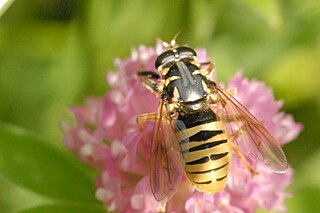
Temnostoma is a genus of hoverflies. The larvae of some species feed on the wood of deciduous trees.

Temnostoma bombylans is a species of hoverfly. Larva of this species feed in decaying wood of deciduous trees.

Temnostoma vespiforme is a species of hoverfly. Larva of this species feed in decaying wood of deciduous trees.

Temnostoma daochus , the Yellow-spotted Falsehorn, is a rare species of syrphid fly observed in the eastern United States. Hoverflies can remain nearly motionless in flight. The adults are also known as flower flies for they are commonly found on flowers, from which they get both energy-giving nectar and protein-rich pollen. Temnostoma adults are strong wasp mimics. The larvae burrow in moist decayed wood.

Temnostoma venustum , the Black-banded Falsehorn , is a rare species of syrphid fly observed in the northeastern United States and adjacent Canada. Hoverflies can remain nearly motionless in flight. The adults are also known as flower flies for they are commonly found on flowers, from which they get both energy-giving nectar and protein rich pollen. Temnostoma adults are strong wasp mimics The larvae burrow in moist decayed wood.

Temnostoma barberi , the Bare-bellied Falsehorn, is a fairly common species of syrphid fly observed in the eastern half of the United States and adjacent areas of Canada. Hoverflies can remain nearly motionless in flight. The adults are also known as flower flies for they are commonly found on flowers, from which they get both energy-giving nectar and protein-rich pollen. Temnostoma adults are strong wasp mimics. The larvae burrow in moist decayed wood.

Temnostoma trifasciatum, the Three-lined Falsehorn, is a rare species of syrphid fly observed in the eastern and central parts of the United States. Hoverflies can remain nearly motionless in flight. The adults are also known as flower flies for they are commonly found on flowers, from which they get both energy-giving nectar and protein-rich pollen. Temnostoma adults are strong wasp mimics. Larvae burrow in moist decayed wood.

Temnostoma apiforme is a species of hoverfly. Larva of this species feed in decaying wood of deciduous trees.
Temnostoma arciforma is a species of syrphid fly in the family Syrphidae.
Temnostoma flavidistriatum is a species of syrphid fly in the family Syrphidae.
Temnostoma ningshanensis is a species of syrphid fly in the family Syrphidae.
Temnostoma altaicum is a species of syrphid fly in the family Syrphidae.
Temnostoma tuwense is a species of syrphid fly in the family Syrphidae.
Temnostoma ravicauda is a species of syrphid fly in the family Syrphidae.
Temnostoma ruptizona is a species of syrphid fly in the family Syrphidae.
Temnostoma jozankeanum is a species of syrphid fly in the family Syrphidae.
Temnostoma taiwanum is a species of syrphid fly in the family Syrphidae.
Temnostoma nigrimanus is a species of syrphid fly in the family Syrphidae.
Temnostoma pallidum is a species of syrphid fly in the family Syrphidae.
Temnostoma pauperius is a species of syrphid fly in the family Syrphidae.







